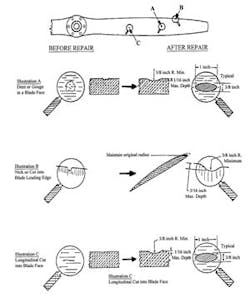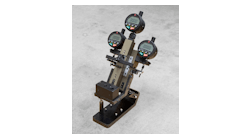Recently the Federal Aviation Administration (FAA) published two Special Airworthiness Information Bulletins (SAIB) for propellers, SAIB # NE-08-20 and SAIB # NE-08-22. These bulletins are not mandatory but are nevertheless very informative. Every certified aircraft maintenance technician should be familiar with these documents, as well as Advisory Circular (AC) 43.13-1B and AC 20-37E, the latter being published specifically for aircraft propeller maintenance, when performing minor repairs on propeller blades.
It would be easy for the casual reader of SAIB NE-08-22 to breeze past an important point on page 2 which calls for “maintenance action or further evaluation prior to return to service: Unusual wear of either unexpected severity or in an unexpected location that might be beyond the manufacturer’s service limits [italics added].” Manufacturer’s service limits are often overlooked by the technician or the “line mechanic” who may be in a hurry to get the minor damage “dressed out” of a blade. The technician is familiar with the diagrams and instructions of the repair limitations such as shown in Figure 1, which is from AC 20-37E. However, individual manufacturers may publish more conservative tolerances to which the technician must adhere. But is this all there is to the manufacturer’s service limits?
Common errors
A technician may look at these repair diagrams and consider the depth of the impact to the blade as the most important criteria when dressing out damage. However, propeller manufacturer product support representatives and field service engineers have stated that the manufacturer’s repair limitations or service limits are often overlooked by mechanics when doing minor repairs such as filing and dressing out nicks on propeller blades.
Often mechanics will fail to take into consideration normal wear and previous blade filing when removing damage. For example, if a manufacturer has a blade repair limit of 0.250 inch maximum material removal on a new blade and a customer gets a nick in the blade requiring that 0.200 inch of material has to be removed as a result of damage, there is only 0.050 inch left that can be removed in the event of future damage. If the blade receives damage again in the same area, it is not enough to simply follow the diagrams that indicate the radius of the repair and the maximum material that can be removed. Even a slight repair may take the blade beyond the service limits.
Another factor the technician needs to take into consideration is whether or not the propeller has previously been reconditioned by an approved propeller overhaul facility. Even though you have a fixed pitch McCauley or Sensenich propeller, for example, it may have been reconditioned or overhauled at some point. When a McCauley fixed pitch propeller is inspected at overhaul, the blades are etched or dressed, having anywhere from 0.002 to 0.003 inch of material removed from the entire surface of the blades. A Sensenich propeller may have as much as 0.005 to 0.007 inch removed from the entire surface of the blades at overhaul. Even though the overhauled propeller looks new, there is less material that can be removed when doing future repairs. Granted, 0.007 inch is not much material but it could still mean the difference between an airworthy or unairworthy propeller.
| |||||||||||||||||||||||||||||||||||||||||||||||||||||||||||||||||||||||||||||||||||||||||||||||||||
Minimum service limits
Each propeller blade has a minimum permissible blade width and thickness at each station of the blade which is critical for maintaining the strength of the blade after it has had minor damage removed. AC 43.13-1B, Section 8-73, cautions the mechanic that the removal of damage must “not materially affect the strength [italics added], weight, or performance of the blade.” For any given blade station, this minimum blade width and thickness, which is critical for the strength of the blade, varies with the manufacturer, propeller model number, blade number, and in some cases, even the diameter of the propeller.
Also, this information is not always easily accessible to the aircraft technician or “line mechanic.”
McCauley states in its Service Manual for McCauley Met-L-Prop Fixed Pitch Propellers: Manual No. 730720 (1973, page 2-8), “Reject blades that will require removal of more material than the minimum permissible widths and thickness in applicable table ...” Similar cautions or warnings may be found in other McCauley overhaul manuals.
Hartzell’s Propeller Owner’s Manual & Logbook: Manual No. 115N (2003) illustrates how to remove damage from its blades. Rather than just a note to customers to not exceed the tolerances for blade repairs, Hartzell now states the caution on page 6-15, “Blades that have been previously repaired or overhauled may have been dimensionally reduced. Before repairing significant damage or making repairs on blades that are approaching serviceable limits, contact an appropriately licensed propeller repair facility or the Hartzell product support department for blade dimensional limits.” So, how does the aircraft mechanic know how much material he or she has to work with?
A very critical inspection that line personnel should be making after performing minor nick and scratch repairs on blades is measuring the blade width and/or thickness at the blade station where the repair was made to make certain there is still the minimum width and/or thickness of the blade at that station. McCauley, Hartzell, and Sensenich, for example, publish minimum blade dimension tables in their appropriate overhaul and/or repair manuals. The mechanic will not find this information in the propeller owner’s manuals. For this reason it is wise to contact an approved propeller repair/overhaul facility, as Hartzell recommends, when repairing questionable blades that have been previously repaired.
| |||||||||||||||||||||||||||||||||||||||||||||||||||||||||||||||||||||||||||||||||||||||||||
Minimum service limit examples
For each propeller make, model, and blade number of modern propellers, the manufacturer publishes what the minimum repaired blade width and thickness is at each blade station. Using the Sensenich table in Figure 2 as an example from Metal Propeller Repair Manual (SPRM) 590, page 10, the technician will find that after filing and dressing out a nick at station (blade radius) 25.88 on a Sensenich 69C fixed pitch propeller blade, the final width must be no less than 4.15 inches. Anything less renders the propeller, in this case, beyond service limits.
Sometimes the variation of width and thickness limitations between blade stations depends upon the diameter of the propeller, even when it is the same blade part number. McCauley, for example, may have different minimum repair limitations at the same blade station of the same blade part number, depending upon what the diameter of the propeller might be. Consider the width difference at station 30 between a 72-inch and 76-inch diameter propeller in McCauley’s Table 4-32 in Figure 3. On the 72-inch diameter propeller the minimum width is 3.83 inches at station 30, and on the 76-inch diameter propeller the minimum width is 3.91 inches at station 30.
Conclusion
In conclusion, when blades are measured to determine the minimum repair dimensions at any given blade station, the measurement is very critical. If the blade station measurement is off even a sixteenth of an inch when determining from a manufacturer’s table what the blade width minimum should be, too much material could conceivably be removed due to the taper of the blade, thereby rendering a blade “unairworthy.” When measurements become too close to call, it is highly recommended to send the propeller to an approved propeller repair/overhaul facility.
Lowell W. Berentsen is an assistant professor, Department of Aviation Technologies, Southern Illinois University, Carbondale, IL. Prior to teaching he worked in Alaska as an AMT on both fixed wing aircraft and helicopters.



